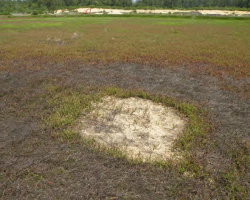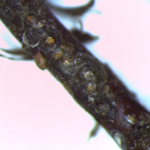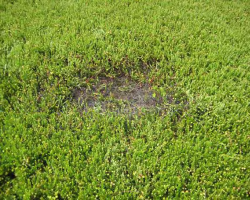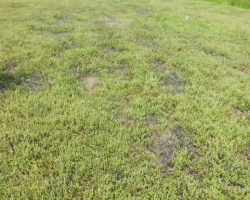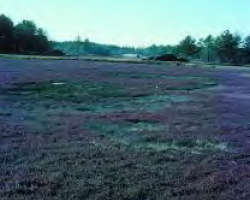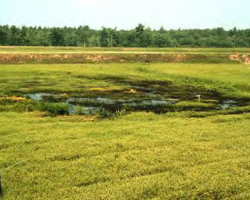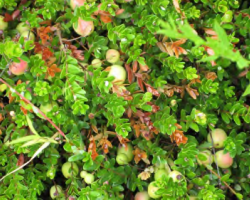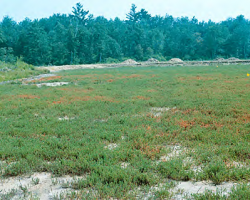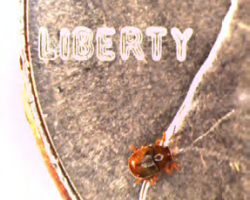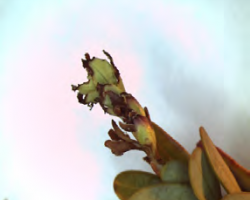Vine Dieback (2014)
Vine Diebacks We Have Seen
Mid-‐summer “Issues of the Day” Workshop; July 23, 2014
UMass Cranberry Station, East Wareham, MA 02538
Instances of localized dieback on commercial cranberry farms have been reported frequently this year. The causes of the dieback are varied. Here are descriptions and characterizations of some of the vine symptoms we have seen:
Scale Injury: See fact sheet in June 5, 2014 Cranberry Station newsletter for more details.
Footprint Disease. These areas look similar to scale injury but the margins of the dead area tend to be green and healthy-‐looking (see photo below). This disease is very new and has been tentatively named “footprint disease”. The diseased areas can increase in size during the season; little regrowth is noted without fungicide treatment. Drs. Peter Oudemans and Jim Polashock at the Pathology lab at Rutgers are attempting to understand the biology of this disease and identify the pathogen. It is thought that the primary pathogen is Pythium, a fungus in the same family as Phytophthora. Current recommendations are to use phosphite fungicides, such as Rampart, K-‐Phite and Phostrol. A few MA growers have used Rampart with good results so far. The fungicides can be applied through the chemigation system. Phosphites are quite water soluble, so apply as with other fungicides and shut down the system as soon as the material has rinsed through the lines. If a lot of water follows application, the fungicide may be washed past the root system and uptake by the vines will be greatly reduced.
Winter Injury (most likely). These small areas of injured vines tend to occur in small depressions in the bog. We believe these areas probably held water (puddled) during the winter, most likely when the ice was dropped. These injured areas do not expand as we do see with Footprint and fairy ring diseases. In fact, by mid-‐summer, many of these areas are showing new growth and recovery. If possible, these areas can be fertilized a little more than healthy areas to encourage vine regrowth. Yield will obviously be lower in these areas but they should recover for next year.
KNOWN DISEASES FOR COMPARISON
Fairy Ring. This disease looks different from the localized patchy spots we have discussed above, but it mentioned here for comparison. Fairy ring can be worse under drought conditions. Fairy rings are usually circular but depending on where they are, they may show as an arc or semi-‐circle. Fairy ring can be spread via harvest equipment, so clean picking machines when moving from bed to bed. Treatment includes fungicides and fertilizers to help vines recover.
Phytophthora Root Rot. Vines die in areas associated with puddling, high water retention, and low spots. After getting a diagnosis, improve drainage first, and then get on a fungicide program. Vines will re-‐colonize affected areas if an integrated approach is used.
Upright Dieback. Usually, patches of vines do not die from URD. Typically you will see “salt and pepper” sprinkling of diseased uprights. Phomopsis is the primary pathogen. This disease is treated with a Bravo application in the spring following diagnosis.
PLUS SOMETHING NEW!
New Beetle. The Entomology lab reports several instances of a new beetle showing up. It feeds on the petals causing the area of bog to appear as a darker patch. It also feeds on the new growth (see photo). The field damage looks very different than the varied “vine diebacks” discussed above. The beetle is very small (smaller than cranberry weevil) and yellowish in color. If you see feeding and/or the beetle, please let the Entomology lab know.
Fact sheet compiled as a joint effort of Anne Averill, Carolyn DeMoranville, Hilary Sandler, and Marty Sylvia. UMass Cranberry Station, East Wareham, MA 02538. July 2014.

